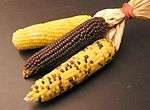Piki
 Piki Bread at a hotel restaurant in Santa Fe, New Mexico | |
| Type | Bread |
|---|---|
| Place of origin | United States |
| Region or state | Western United States |
| Main ingredients | Corn meal, blue corn, ashes, water |
|
| |
Piki is a bread made from corn meal used in Hopi cuisine.
Preparation
Blue corn, a staple grain of the Hopi, is first reduced to a fine powder on a metate. It is then mixed with water and burnt ashes of native bushes or juniper trees[1][2][3] for purposes of nixtamalization (nutritional modification of corn by means of lime or other alkali). The thin batter is then smeared by hand over a large flat baking stone that has been heated over a fire and coated with oil made from pounded seeds of the native American plants squash and sunflower, and also from the seeds of watermelon, which though originally from Africa, has been in the Americas for at least 500 years.[4] Piki bread bakes almost instantaneously and is peeled from the rock in sheets so thin they are translucent.[5] Several sheets of the bread are often rolled up loosely into flattened scrolls.[6]
Piki takes several days to make from scratch. Piki is prepared by women in various phases of the courtship and marriage ritual. It is eaten by the couple on the morning of the marriage ceremony.[7][8]
See also
References
- ↑ Linda Murray Berzok (2005). American Indian Food. Greenwood Press. ISBN 978-0-313-32989-0. Retrieved 2007-10-15.
- ↑ Jennie Rose Joeand Robert S. Young (1993). Diabetes As a Disease of Civilization: The Impact of Culture Change on Indigenous People. Walter de Gruyter. ISBN 978-3-11-013474-2. Retrieved 2007-10-15.
- ↑ Gale Jack and Alex Jack. "Whole Grains and Grain liroducts". Amberwaves. Retrieved 2007-10-15.
- ↑ Daniel E. Moerman (1998). Native American ethnobotany. Timber Press. ISBN 978-0-88192-453-4. Retrieved 2007-10-15.
- ↑ Carol Locust (1994). The Piki Maker: Disabled American Indians, Cultural Beliefs, and Traditional Behaviors. Native American Research and Training Center, University of Arizona.
- ↑ Lois Essary Jacka (October 2, 1998). "On the Mesas of the Hopis". New York Times. Retrieved 2007-10-15.
- ↑ Sharon Watts (2003). Bride's Book of Etiquette. Conde Nast Publications. ISBN 978-0-8058-9566-7.
- ↑ Robert Boissiere (1985). the Hopi way. Sunstone Press. ISBN 978-0-86534-055-8. Retrieved 2007-10-15.
